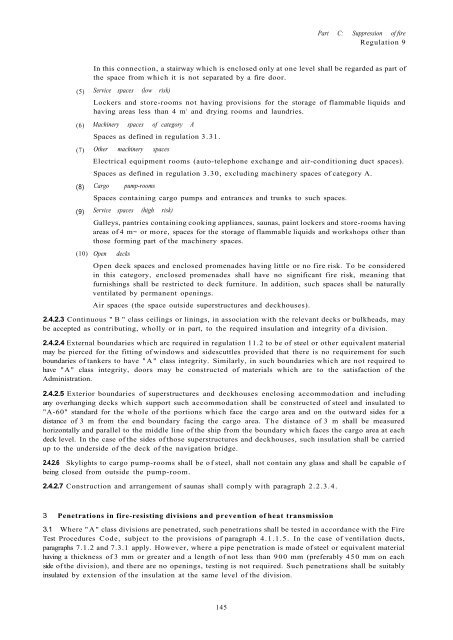Solas Consolidated Edition 2009.pdf
Solas Consolidated Edition 2009 for maritime
Solas Consolidated Edition 2009 for maritime
You also want an ePaper? Increase the reach of your titles
YUMPU automatically turns print PDFs into web optimized ePapers that Google loves.
Part C: Suppression of fire<br />
Regulation 9<br />
In this connection, a stairway which is enclosed only at one level shall be regarded as part of<br />
the space from which it is not separated by a fire door.<br />
(5)<br />
(6)<br />
(7)<br />
(8)<br />
(9)<br />
(10)<br />
Service spaces (low risk)<br />
Lockers and store-rooms not having provisions for the storage of flammable liquids and<br />
having areas less than 4 m 2<br />
and drying rooms and laundries.<br />
Machinery spaces of category A<br />
Spaces as defined in regulation 3.31.<br />
Other machinery spaces<br />
Electrical equipment rooms (auto-telephone exchange and air-conditioning duct spaces).<br />
Spaces as defined in regulation 3.30, excluding machinery spaces of category A.<br />
Cargo<br />
pump-rooms<br />
Spaces containing cargo pumps and entrances and trunks to such spaces.<br />
Service spaces (high risk)<br />
Galleys, pantries containing cooking appliances, saunas, paint lockers and store-rooms having<br />
areas of 4 m~ or more, spaces for the storage of flammable liquids and workshops other than<br />
those forming part of the machinery spaces.<br />
Open<br />
decks<br />
Open deck spaces and enclosed promenades having little or no fire risk. To be considered<br />
in this category, enclosed promenades shall have no significant fire risk, meaning that<br />
furnishings shall be restricted to deck furniture. In addition, such spaces shall be naturally<br />
ventilated by permanent openings.<br />
Air spaces (the space outside superstructures and deckhouses).<br />
2.4.2.3 Continuous "B" class ceilings or linings, in association with the relevant decks or bulkheads, may<br />
be accepted as contributing, wholly or in part, to the required insulation and integrity of a division.<br />
2.4.2.4 External boundaries which arc required in regulation 11.2 to be of steel or other equivalent material<br />
may be pierced for the fitting of windows and sidescuttles provided that there is no requirement for such<br />
boundaries of tankers to have "A" class integrity. Similarly, in such boundaries which are not required to<br />
have "A" class integrity, doors may be constructed of materials which are to the satisfaction of the<br />
Administration.<br />
2.4.2.5 Exterior boundaries of superstructures and deckhouses enclosing accommodation and including<br />
any overhanging decks which support such accommodation shall be constructed of steel and insulated to<br />
"A-60" standard for the whole of the portions which face the cargo area and on the outward sides for a<br />
distance of 3 m from the end boundary facing the cargo area. The distance of 3 m shall be measured<br />
horizontally and parallel to the middle line of the ship from the boundary which faces the cargo area at each<br />
deck level. In the case of the sides of those superstructures and deckhouses, such insulation shall be carried<br />
up to the underside of the deck of the navigation bridge.<br />
2.4.2.6 Skylights to cargo pump-rooms shall be of steel, shall not contain any glass and shall be capable of<br />
being closed from outside the pump-room.<br />
2.4.2.7 Construction and arrangement of saunas shall comply with paragraph 2.2.3.4.<br />
3 Penetrations in fire-resisting divisions and prevention of heat transmission<br />
3.1 Where "A" class divisions are penetrated, such penetrations shall be tested in accordance with the Fire<br />
Test Procedures Code, subject to the provisions of paragraph 4.1.1.5. In the case of ventilation ducts,<br />
paragraphs 7.1.2 and 7.3.1 apply. However, where a pipe penetration is made of steel or equivalent material<br />
having a thickness of 3 mm or greater and a length of not less than 900 mm (preferably 450 mm on each<br />
side of the division), and there are no openings, testing is not required. Such penetrations shall be suitably<br />
insulated by extension of the insulation at the same level of the division.<br />
145


